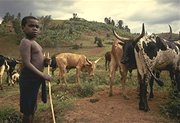Non-kinship Based Social Groups
All societies classify people to some degree
based on their age. In North America, for example, we generally label
people as children, teenagers, adults, middle aged, and elderly or senior
citizens. Such age-based categories are referred to by anthropologists
as age grades. They are in a sense both achieved and ascribed
statuses. People become senior citizens simply by living long
enough. In other words, they have achieved this status through longevity. On the other
hand, grandchildren cannot achieve elder status at the same time as their
grandparents because they were born much later--there is
an ascribed difference between them. In time, however, they also can
become senior citizens.
In some societies, age grades are clearly recognized as distinct identifiable groups of people. Anthropologists refer to these groups as age sets. They are people of similar age and usually of the same gender who share a common identity and maintain close ties throughout their lives. They also pass through age-related statuses together as a group. The transition between these statuses is usually marked by a rite of passage.
Age sets are especially common in
sub-Saharan
Africa. Among the 1/4 million Masai
![]() cattle herding people of southern Kenya and northern Tanzania, for instance, male age-sets
have been
traditionally very important. The Masai strongly differentiate three major
age-based male groups--boys, warriors, and elders. The latter two groups are
also informally divided into junior and senior warriors and junior and
senior elders.
cattle herding people of southern Kenya and northern Tanzania, for instance, male age-sets
have been
traditionally very important. The Masai strongly differentiate three major
age-based male groups--boys, warriors, and elders. The latter two groups are
also informally divided into junior and senior warriors and junior and
senior elders.
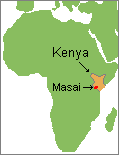 |
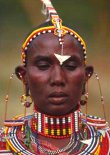 |
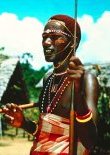 |
||
| Masai territory | Masai woman and man (elder) | |||
From the age of 6-8, Masai boys spend much
of their time on their own, away from the community, sharing the work of herding cattle owned by
their parents. At this time they develop the close male relationships
that will last throughout their lives. When they are 12-14, boys are
circumcised together in a
ritual that marks their transition to a new status--they become morans
![]() ,
or warriors. In Masai culture, only morans are allowed to have long hair. They also
dress differently and spend much of their time away from the community in a
hidden training camp. They
no longer herd cattle but now are responsible for their defense against
predators such as lions and people who might steal them. While boys are
not allowed to carry spears, morans do. They must remain
unmarried during the 7 years that they are morans, but some of them secretly have
girlfriends. In their twenties, the moran once again go through a rite of passage together.
It marks their transition to the elder status and role within
society. They reinforce their camaraderie at this time by drinking the blood of a
freshly killed cow that has been specially sacrificed for the purpose, and their
long hair is shaved off by their mothers to signify their new status.
They are no longer warriors but are becoming respected decision makers and spokesmen
for their families and communities. As elders, they are now allowed to get married when they can acquire sufficient
numbers of cattle to pay a bride
price. In Masai society girls usually marry in their teens and men in
their thirties and later. Middle aged and older men typically have
several wives.
,
or warriors. In Masai culture, only morans are allowed to have long hair. They also
dress differently and spend much of their time away from the community in a
hidden training camp. They
no longer herd cattle but now are responsible for their defense against
predators such as lions and people who might steal them. While boys are
not allowed to carry spears, morans do. They must remain
unmarried during the 7 years that they are morans, but some of them secretly have
girlfriends. In their twenties, the moran once again go through a rite of passage together.
It marks their transition to the elder status and role within
society. They reinforce their camaraderie at this time by drinking the blood of a
freshly killed cow that has been specially sacrificed for the purpose, and their
long hair is shaved off by their mothers to signify their new status.
They are no longer warriors but are becoming respected decision makers and spokesmen
for their families and communities. As elders, they are now allowed to get married when they can acquire sufficient
numbers of cattle to pay a bride
price. In Masai society girls usually marry in their teens and men in
their thirties and later. Middle aged and older men typically have
several wives.
|
|
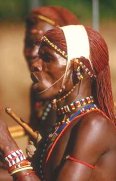 |
|
NOTE: There is not universal agreement as to how the word "Masai" should be spelled. Some prefer "Maasai."
Age sets also exist in other parts of the world but are generally not as important as they are in sub-Saharan Africa. For example, students who attend prestigious private universities such as Harvard, Yale, Oxford, and Cambridge usually identify with the members of their graduation class and keep in contact with them throughout their lives. They get together for reunions and help each other get jobs or arrange business deals. They generally see themselves as a closed group of people who have shared a common experience and continue to have common interests.
Gender-based Groups
In addition to age, gender is also a universal basis for organizing social groups. While both men's and women's groups occur, men's associations are more common around the world. When gender-based groups exist in small-scale societies, every adult of the same gender is usually a member. In large-scale societies, gender-based groups become more institutionalized and membership is usually not mandatory. Typical gender-based groups in North America include the Boy Scouts and Girl Scouts, fraternities, sororities, and lodges (e.g., Elks, Masons, etc.).
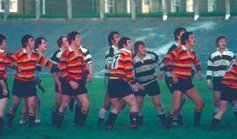 |
In Britain, male rugby clubs like this one from Carmathan Wales are important gender-based community groups that regularly socialize together. |
Groups Based on Common Interest
Voluntary associations based primarily on common interest and experience are also widespread forms of non-kinship based groups, especially in large-scale societies. Such groups are likely to have one of the following focuses:
| 1. | vocation (e.g., trade unions, professional associations) |
| 2. | avocation (e.g., leisure activity clubs, fraternal organizations) |
| 3. | common residence (e.g., neighborhood associations) |
| 4. | religious belief (e.g., membership in a church or other religious organization) |
| 5. | political belief (e.g., political action groups, political parties) |
| 6. | past experience (e.g., widows clubs, veterans organizations, cancer survivors groups) |
Membership in voluntary associations is usually based on achieved status in addition to common interest. For instance, members of the American Medical Association are trained medical professionals (an achieved status) in addition to having a common interest in supporting and advancing the medical profession in the United States.
In some cases, voluntary associations are based on ascribed status or a combination of ascribed and achieved status. For instance, organizations based on social or economic classes commonly appear as a result of unequal access to wealth and power in large-scale societies. These groups are likely to occur at all levels of society. They may be clubs of rich and powerful families who have had this status for generations--i.e., they are from "old money" families. At the other end of the economic spectrum, there may be gangs of relatively poor, disenfranchised youths. Cross-cutting these largely ascribed class-based groups may be others based on ethnic or racial identity.
Voluntary associations are less common in small-scale societies. However, when they do occur, they are usually male military associations, secret societies, or religious cults. In some indigenous societies of New Guinea, men traditionally lived together in a "big house" where they shared the secrets of their religious belief system. There were religious cults that were largely kept secret from women and very young children. Among the Indians of the North American Plains, men commonly belonged to warrior societies.
